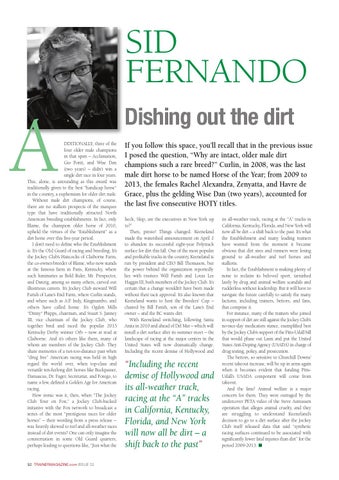FERNANDO NA ISSUE 32_Jerkins feature.qxd 17/04/2014 22:44 Page 1
SID FERNANDO
A
DDITIONALLY, three of the four older male champions in that span – Acclamation, Gio Ponti, and Wise Dan (two years) – didn’t win a single dirt race in four years. This, alone, is astounding as this award was traditionally given to the best “handicap horse“ in the country, a euphemism for older dirt male. Without male dirt champions, of course, there are no stallion prospects of the marquee type that have traditionally attracted North American breeding establishments. In fact, only Blame, the champion older horse of 2010, upheld the virtues of the “Establishment” as a dirt horse over this five-year period. I don’t need to define who the Establishment is. It’s the Old Guard of racing and breeding. It’s the Jockey Club’s Hancocks of Claiborne Farm, the co-owner-breeder of Blame, who now stands at the famous farm in Paris, Kentucky, where such luminaries as Bold Ruler, Mr. Prospector, and Danzig, among so many others, carved out illustrious careers. It’s Jockey Club steward Will Farish of Lane’s End Farm, where Curlin stands, and where such as A.P. Indy, Kingmambo, and others have called home. It’s Ogden Mills “Dinny“ Phipps, chairman, and Stuart S. Janney III, vice chairman of the Jockey Club, who together bred and raced the popular 2013 Kentucky Derby winner Orb – now at stud at Claiborne. And it’s others like them, many of whom are members of the Jockey Club. They share memories of a not-too-distance past when “drug free” American racing was held in high regard the world over, when top-class and versatile ten-furlong dirt horses like Buckpasser, Damascus, Dr. Fager, Secretariat, and Forego, to name a few, defined a Golden Age for American racing. How ironic was it, then, when “The Jockey Club Tour on Fox,” a Jockey Club-backed initiative with the Fox network to broadcast a series of the most “prestigious races for older horses” – their wording from a press release – was heavily skewed to turf and all-weather races instead of dirt events? One can only imagine the consternation in some Old Guard quarters, perhaps leading to questions like, “Just what the
92 TRAINERMAGAZINE.com ISSUE 32
Dishing out the dirt If you follow this space, you’ll recall that in the previous issue I posed the question, “Why are intact, older male dirt champions such a rare breed?” Curlin, in 2008, was the last male dirt horse to be named Horse of the Year; from 2009 to 2013, the females Rachel Alexandra, Zenyatta, and Havre de Grace, plus the gelding Wise Dan (two years), accounted for the last five consecutive HOTY titles. heck, Skip, are the executives in New York up to?” Then, presto! Things changed. Keeneland made the watershed announcement on April 2 to abandon its successful eight-year Polytrack surface for dirt this fall. One of the most popular and profitable tracks in the country, Keeneland is run by president and CEO Bill Thomason, but the power behind the organization reportedly lies with trustees Will Farish and Louis Lee Haggin III, both members of the Jockey Club. It’s certain that a change wouldn’t have been made without their tacit approval. It’s also known that Keeneland wants to host the Breeders’ Cup – chaired by Bill Farish, son of the Lane’s End owner – and the BC wants dirt. With Keeneland switching, following Santa Anita in 2010 and ahead of Del Mar – which will install a dirt surface after its summer meet – the landscape of racing at the major centers in the United States will now dramatically change. Including the recent demise of Hollywood and
“Including the recent demise of Hollywood and its all-weather track, racing at the “A” tracks in California, Kentucky, Florida, and New York will now all be dirt – a shift back to the past”
its all-weather track, racing at the “A” tracks in California, Kentucky, Florida, and New York will now all be dirt – a shift back to the past. It’s what the Establishment and many leading trainers have wanted from the moment it became obvious that dirt sires and runners were losing ground to all-weather and turf horses and stallions. In fact, the Establishment is making plenty of noise to reclaim its beloved sport, tarnished lately by drug and animal welfare scandals and rudderless without leadership. But it will have to navigate the future carefully to satisfy the many factions, including trainers, bettors, and fans, that comprise it. For instance, many of the trainers who joined in support of dirt are still against the Jockey Club’s no-race-day medication stance, exemplified best by the Jockey Club’s support of the Pitts-Udall bill that would phase out Lasix and put the United States Anti-Doping Agency (USADA) in charge of drug testing, policy, and prosecution. The bettors, so sensitive to Churchill Downs’ recent takeout increase, will be up in arms again when it becomes evident that funding PittsUdall’s USADA component will come from takeout. And the fans? Animal welfare is a major concern for them. They were outraged by the undercover PETA video of the Steve Asmussen operation that alleges animal cruelty, and they are struggling to understand Keeneland’s decision to go to a dirt surface after the Jockey Club itself released data that said “synthetic racing surfaces continued to be associated with significantly fewer fatal injuries than dirt” for the period 2009-2013. n
